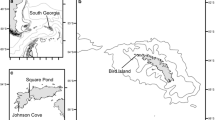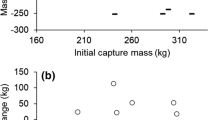Abstract
Endogenous reserves influence both survival and reproduction of many waterfowl species, but little is known about reserve levels of most species during the nonbreeding season, particularly those wintering at high latitudes. We investigated whether age, sex, and season were related to carcass composition of northern common eiders (Somateria mollissima borealis) wintering in southwest Greenland during 1999–2002. Adults carried more lipid and protein than juveniles during all winters. Among both age classes, males and females had similar fat levels but males carried slightly more protein. There was no dramatic seasonal variation in lipid or protein content. This suggests that during the period of this study, these eiders did not experience large-scale nutritional shortfalls. As predicted, Greenlandic eiders carried more lipid reserves than eider populations wintering in more temperate environments. Contrary to prediction, there was little relation between reserve levels and photoperiod, ambient temperature, or hunting disturbance intensity. Our results suggest that both sexes are equally capable of dealing with nutritional deficits, and that juvenile birds are more prone to nutritional stress as evidenced by their consistently poorer body condition.


Similar content being viewed by others
References
Barboza PS, Jorde DG (2002) Intermittent fasting during winter and spring affects body composition and reproduction of a migratory duck. J Comp Physiol B 172:419–434
Beer JV (1963) The rapid sexing of downy Anatidae by the structure of the syrinx. Wildfowl 14:160–162
Bell DV, Owen M (1990) Shooting disturbance—a review. In: Matthews GVT (ed) Managing waterfowl populations. IWRB special publication no 12. Slimbridge, pp 159–171
Blem CR (1990) Avian energy storage. Curr Ornithol 7:59–113
Boertmann D, Lyngs P, Merkel FR, Mosbech A (2004) The significance of SW Greenland as winter quarters for seabirds. Birds Conserv Int 14:87–112
Boos M, Zorn T, Le Maho Y, Groscolas R, Robin JP (2002) Sex differences in body composition of wintering Mallards (Anas platyrhynchos): possible implications for survival and reproductive performance. Bird Study 49:212–215
Camphuysen CJ (2001) Eider mortality in the Dutch Wadden Sea, winter 1999–2000. Wadden Sea Newsletter 2001 No. 1 Special Issue; Eider Mortality, pp 4–5
Christensen TK (2000) Female pre-nesting foraging and male vigilance in Common Eider Somateria mollissima. Bird Study 47:311–319
Gaston GR (1991) Effects of environment and hunting on body condition of nonbreeding Gadwalls (Anas strepera, Anatidae) in Southwestern Louisiana. Southwest Nat 36:318–322
Gaston AJ, Cooch FG (1984) Observations of common eiders in Hudson Strait: aerial surveys in 1980–83. In: Reed A (ed) Eider ducks in Canada. Report Series No. 47. Canadian Wildlife Service, Ottawa, pp 51–54
Gates RJ, Caithamer DF, Moritz WE, Tacha TC (2001) Bioenergetics and nutrition of Mississippi Valley population Canada Geese during winter and migration. Ecol Monogr 146:1–65
Gauthier G, Choinière L, Savard J-PL (1992a) Nutrient reserves of wintering American Black Ducks in the St. Lawrence estuary, Quebec. Canadian Wildlife Service. Report #202
Gauthier G, Giroux JF, Bédard J (1992b) Dynamics of fat and protein reserves during winter and spring migration in greater snow geese. Can J Zool 70:2077–2087
Gorman ML, Milne H (1971) Seasonal changes in the adrenal steroid tissue of the Common Eider Somateria mollissima and its relation to organic metabolism in normal and oil-polluted birds. Ibis 113:218–228
Goss-Custard JD, Dit Durell SEALV (1987) Age-related effects in Oystercatchers, Haematopus ostralegus, feeding on mussels, Mytilus edulis, I. foraging efficiency and interference. J Anim Ecol 56:521–536
Goudie RI, Robertson GJ, Reed A (2000) Common Eider. In: Poole A, Gill F (eds) The birds of North America, No. 546. Birds of North America, Inc., Philadelphia
Griminger P (1986) Lipid metabolism. In: Sturkie PD (ed) Avian physiology. Springer, Berlin Heidelberg New York, pp 345–358
Guillemette M, Ydenberg R, Himmelman JH (1992) The role of energy intake rate in prey and habitat selection of common eiders Somateria mollissima in winter: a risk sensitive interpretation. J Anim Ecol 61:599–610
Hanssen SA, Engebretsen H, Erikstad KE (2002) Incubation start and egg size in relation to body reserves in the Common Eider. Behav Ecol Sociobiol 52:282–288
Hepp GR (1984) Dominance in wintering Anatinae: potential effects on clutch size and time of nesting. Wildfowl 35:132–134
Hohman WL, Ankney CD (1994) Body size and condition, age, plumage quality, and food of prenesting male Cinnamon Teal in relation to pair status. Can J Zool 72:2172–2176
Hohman WL, Ankney CD, Roster DL (1992) Body condition, food habits, and molt status of late-wintering Ruddy Ducks in California. Southwest Nat 37:298–273
Jamieson SE, Gilchrist HG, Merkel FR, Falk K, Diamond AW (2006) An evaluation of methods used to estimate carcass composition of Common Eiders. Wildl Biol (in press)
Jenssen BM, Ekker M, Bech C (1989) Thermoregulation in winter-acclimatized common eiders (Somateria mollissima) in air and water. Can J Zool 67:669–673
Jorde DG, Krapu GL, Crawford RD, Hay MA (1984) Effects of weather on habitat selection and behavior of Mallards wintering in Nebraska. Condor 86:258–265
Kendeigh SC (1970) Energy requirements for existence in relation to size of bird. Condor 72:60–65
Kestenholz M (1994) Body mass dynamics of wintering Tufted Ducks Aythya fuligula and Pochard A. ferina in Switzerland. Wildfowl 45:147–158
Korschgen CE (1977) Breeding stress of female eiders in Maine. J Wildl Manage 41:360–373
Lima SL (1986) Predation risk and unpredictable feeding conditions: determinants of body mass in birds. Ecology 67:377–385
Lovvorn JR (1994) Nutrient reserves, probability of cold spells, and the question of reserve regulation in wintering Canvasbacks. J Anim Ecol 63:11–23
Lyngs P (2003) Migration and winter ranges of birds in Greenland—an analysis of ringing recoveries. Dansk Ornithologisk Forenings Tidsskrift 97:1–167
MacCharles AM (1997) Diving and foraging behaviour of wintering common eiders (Somateria mollissima) at Cape St. Mary’s, Newfoundland. MSc Thesis. Simon Fraser University
Mather DD, Esler D (1999) Evaluation of bursal depth as an indicator of age class of Harlequin Ducks. J Field Ornithol 70:200–205
Merkel FR (2004) Impact of hunting and gillnet fishery on wintering eiders in Nuuk, Southwest Greenland. Waterbirds 27:469–479
Merkel FR, Mosbech A, Boertmann D, Grøndahl L (2002) Winter seabird distribution and abundance off south-western Greenland, 1999. Polar Res 21:17–36
Merkel FR, Falk K, Jamieson SE (2006) Impact on body condition of embedded lead shot in common eiders Somateria mollissima. J Wildl Manage (in press)
Milne H (1976) Body weights and carcass composition of the Common Eider. Wildfowl 27:115–122
Parker H, Holm H (1990) Patterns of nutrient and energy expenditure in female common eiders nesting in the high Arctic. Auk 107:660–668
Pattenden RK, Boag DA (1989) Effects of body mass, pairing, and reproduction in captive Mallards. Can J Zool 67:495–501
Pehrsson O (1984) Diving duck populations in relation to their food supplies. In: Evans PR, Goss-Custard JD, Hale WG (eds) Coastal waders and wildfowl in winter. Cambridge University Press, Cambridge, pp 101–116
Peterson SR, Ellarson RS (1979) Changes in Oldsquaw carcass weight. Wilson Bull 91:288–300
Robertson GJ, Gilchrist HG (1998) Evidence of population declines among common eiders breeding in the Belcher Islands, Northwest Territories. Arctic 51:378–385
Rogers CM, Nolan V, Ketterson ED (1993) Geographic variation in winter fat of dark-eyed Juncos: displacement to a common environment. Ecology 74:1183–1190
Rohwer FC, Anderson MG (1988) Female-biased philopatry, monogamy, and the timing of pair formation in migratory waterfowl. Curr Ornithol l5:187–221
Spurr EB, Milne H (1976) Adaptive significance of autumn pair formation in the Common Eider Somateria mollissima (L.). Ornis Scand 7:85–89
Systad GH, Bustnes JO (2001) Coping with darkness and low temperatures: foraging strategies in Steller’s Eiders, Polysticta stelleri, wintering at high latitudes. Can J Zool 79:402–406
Systad GH, Bustnes JO, Erikstad KE (2000) Behavioural responses to decreasing day length in wintering sea ducks. Auk 117:33–40
SYSTAT Software, Inc (1999) SYSTAT version 9, Richmond
Williams JE, Kendeigh SC (1982) Energetics of the Canada Goose. J Wildl Manage 46:588–600
Witter MS, Cuthill IC (1993) The ecological costs of avian fat storage. Philos Trans R Soc Lond B 340:73–92
Acknowledgements
This project was supported by the Canadian Wildlife Service, Greenland Institute of Natural Resources, Danish Environmental Protection Agency, and the Atlantic Cooperative Wildlife Ecology Research Network. We would like to thank Jason Akearok, Alain Fontaine, Kristian Heilmann, Mark Mallory, Myra Robertson, and Karl Tobiasen for assistance with collections. We would also like to thank Dave Ankney for many helpful discussions and allowing SEJ to work in his Avian Energetic Laboratory at the University of Western Ontario, London, Ontario. We are indebted to Joël Bêty, Mark Dionne, Ian Goudie, Diana Hamilton, and Dan Keppie for helpful discussions. Comments by Dan Esler, Graham Forbes, Greg Robertson, and anonymous reviewers greatly improved earlier versions of this manuscript.
Author information
Authors and Affiliations
Corresponding author
Rights and permissions
About this article
Cite this article
Jamieson, S.E., Gilchrist, H.G., Merkel, F.R. et al. Endogenous reserve dynamics of northern common eiders wintering in Greenland. Polar Biol 29, 585–594 (2006). https://doi.org/10.1007/s00300-005-0093-2
Received:
Revised:
Accepted:
Published:
Issue Date:
DOI: https://doi.org/10.1007/s00300-005-0093-2




